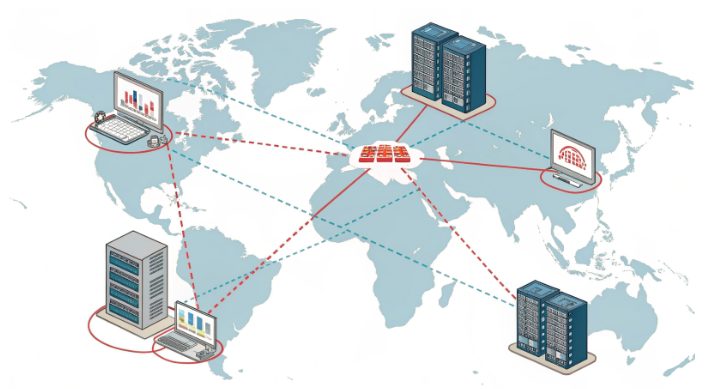APAC Read-Replica Clusters via HK Bandwidth

Hong Kong stands as a pivotal network hub in the APAC region, with its international bandwidth acting as a backbone for seamless cross-border data flow. For tech teams aiming to optimize data accessibility across Asia, leveraging Hong Kong international bandwidth to build APAC read-replica clusters emerges as a strategic move. This article dives into the technicalities, benefits, and step-by-step implementation, highlighting the role of Hong Kong hosting in this ecosystem.
Advantages of Hong Kong International Bandwidth
- Strategic Geographic Hub: Positioned at the crossroads of APAC, enabling direct and efficient connections to major economies like China, Japan, Singapore, and Australia.
- Ample Bandwidth Capacity: Boasts extensive fiber optic infrastructure, supporting multi-terabit data transfer to handle high-volume read operations across the cluster.
- Ultra-Low Latency: Typical round-trip times (RTT) to key APAC cities range from 20-80ms, critical for real-time data synchronization in read-replica setups.
- Carrier-Neutral Resilience: Redundant network paths through multiple Tier 1 ISPs minimize downtime risks, ensuring 99.99%+ uptime for cluster operations.
Understanding Read-Replica Clusters
A read-replica cluster is a distributed database architecture comprising:
- A primary database instance handling write operations and transactional consistency.
- Multiple read-only replicas syncing data from the primary via asynchronous or semi-synchronous replication.
Key functionalities include:
- Offloading 70-90% of read traffic from the primary, preventing resource bottlenecks.
- Enabling geographically distributed read endpoints, reducing access latency for regional users.
- Enhancing fault tolerance – replicas act as hot standbys if the primary fails.
Role of Hong Kong Hosting in APAC Clusters
Hong Kong hosting serves as the linchpin for APAC read-replica clusters due to:
- Proximity to Core Markets: Hosting replicas in Hong Kong reduces data travel distance to East Asian and Southeast Asian users, cutting query response times by 40-60% compared to US-based nodes.
- Hardware Optimization: Local data centers offer high-performance SSD storage and multi-core processors, critical for handling concurrent read requests from APAC regions.
- Bandwidth Synergy: Hong Kong hosting integrates seamlessly with the region’s international bandwidth, ensuring minimal packet loss during cross-replica synchronization (typically below 0.1%).
- Regulatory Compliance: Aligns with APAC data residency requirements, avoiding latency penalties from cross-jurisdictional data transfers.
Building the Cluster: Technical Workflow
-
Select Nodes
- Opt for bare-metal servers with 10Gbps+ network interfaces to handle inter-replica sync.
- Ensure storage IOPs exceed 10,000 to support parallel read operations.
- Verify ISP peering with target APAC regions (e.g., NTT, Telstra, China Telecom).
-
Design Network Topology
- Implement a mesh VPN overlay for secure inter-replica communication.
- Configure BGP routing to prioritize Hong Kong international bandwidth for cross-region data flows.
- Set up load balancers with geographic routing policies (e.g., route Tokyo users to Hong Kong replica).
-
Configure Replication Mechanisms
- Use MySQL GTID or PostgreSQL WAL for point-in-time recovery capabilities.
- Set sync intervals based on RTT: 1-5s for APAC replicas, 10-30s for distant nodes.
- Implement conflict resolution logic for semi-sync scenarios.
-
Validate and Optimize
- Run load tests with 10k+ concurrent users simulating APAC traffic patterns.
- Monitor replication lag via Prometheus/Grafana dashboards (target: <2s).
- Tune TCP window sizes to maximize throughput over Hong Kong international bandwidth.
Case Study: E-Commerce Platform Deployment
A regional e-commerce giant migrated from a US-centric setup to a Hong Kong-based read-replica cluster, achieving:
- 58% reduction in page load times for APAC users (from 800ms to 330ms).
- 99.99% uptime during peak sales events (e.g., 11.11 shopping festival).
- 30% lower cloud egress costs by leveraging Hong Kong international bandwidth efficiency.
Conclusion
Hong Kong international bandwidth provides the foundational infrastructure for building high-performance APAC read-replica clusters. When paired with the optimized hosting, it delivers unparalleled latency, scalability, and reliability for distributed database architectures. By following the technical workflow outlined, engineering teams can deploy resilient clusters that meet the demands of APAC’s growing digital ecosystem. Embracing this approach ensures your data layer keeps pace with regional user expectations, making Hong Kong international bandwidth and hosting indispensable components of modern APAC tech stacks.

